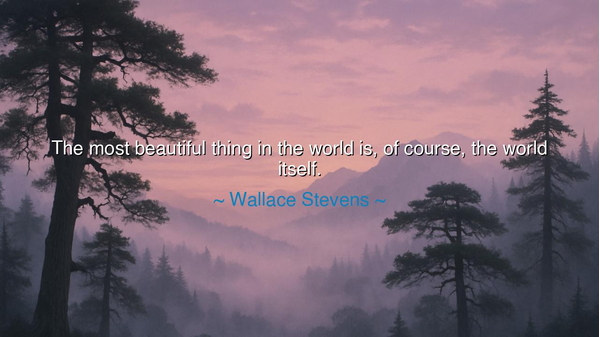
The most beautiful thing in the world is, of course, the world






“The most beautiful thing in the world is, of course, the world itself.”
Thus spoke Wallace Stevens, the poet of the invisible made visible, the philosopher of imagination and reality intertwined. In this simple yet profound declaration, he reminds us that beauty is not a distant dream or an artificial creation — it is the world itself, the living tapestry of sky and stone, of breath and water, of joy and sorrow alike. Stevens saw beauty not as something that must be sought beyond the horizon, but as something ever-present, waiting for the eyes of wonder to behold it. His words call us back to what we have forgotten: that the ordinary world is not ordinary at all, but a miracle unfolding every moment.
Wallace Stevens was a man of paradox — a poet who lived much of his life as a quiet insurance executive, yet whose inner world shimmered with imagination. In his poetry, he explored the eternal dialogue between the mind and the universe, between perception and truth. When he said that “the most beautiful thing in the world is, of course, the world itself,” he was not dismissing art, dreams, or philosophy. He was revealing the foundation beneath them all — that art and thought are born from the raw, divine beauty of existence. To love the world as it is, he believed, is to see with the eyes of a poet, to find transcendence within reality itself.
This quote echoes the ancient wisdom of those who walked before us. The Stoics taught that virtue begins in alignment with nature — that to live well, one must first see and accept the world as it is. The Buddha, too, taught that enlightenment is not found by fleeing the world, but by awakening to it fully, with compassion and clarity. And the indigenous sages of every land have known that the earth itself is sacred scripture, written in trees, rivers, and winds. Stevens, though a modern man, carried this ancient understanding in his heart — that the world is not a backdrop for our lives, but the living source of all beauty and wisdom.
To understand his meaning, consider the story of Ansel Adams, the great photographer of the American wilderness. Adams spent his life capturing mountains, clouds, and deserts, not to glorify himself, but to show the world its own reflection. Standing before the grandeur of Yosemite, he saw what Stevens saw — that no creation of man could surpass the majesty of creation itself. His camera became a prayer, his images a reminder that the world, when seen with reverence, becomes a cathedral of light. Adams once said, “I believe the world is incomparably beautiful.” In this, he and Stevens spoke the same truth: that beauty is not made — it is revealed through awareness.
Yet how easily we forget this. The modern heart, chasing comfort and conquest, grows blind to the simple miracles of being alive. We hunger for artificial beauty — for the shine of possessions, the glamour of screens — while overlooking the divine artistry of dawn, the music of rain, the laughter of a friend. Stevens’s words strike like a gentle bell to awaken us from this sleep. They remind us that the world has never stopped offering itself to us, radiant and abundant, waiting for our gratitude to open the door.
The lesson, then, is to live with eyes open and hearts attuned to wonder. Look not only at what you desire, but at what already is. The sunrise that paints the earth in fire, the wind that touches your skin, the breath that moves through your chest — these are not small things. They are the living proof that you dwell within something vast and sacred. Each moment is a jewel; each day, a chance to behold the infinite through the finite. To truly live, one must learn to see the world as it deserves to be seen — not as a possession, but as a gift.
So, my child of earth and breath, take this teaching to heart: “The most beautiful thing in the world is, of course, the world itself.” Seek not escape from life, but presence within it. Stand beneath the open sky and remember that you are part of its vastness. Drink deeply of the world’s beauty — its storms and its stillness, its sorrow and its joy — for all are facets of the same divine brilliance. And when you see the world thus, with eyes cleansed by awe and gratitude, you will find that heaven is not elsewhere, nor beyond death, but here — shimmering in the world itself.






AAdministratorAdministrator
Welcome, honored guests. Please leave a comment, we will respond soon